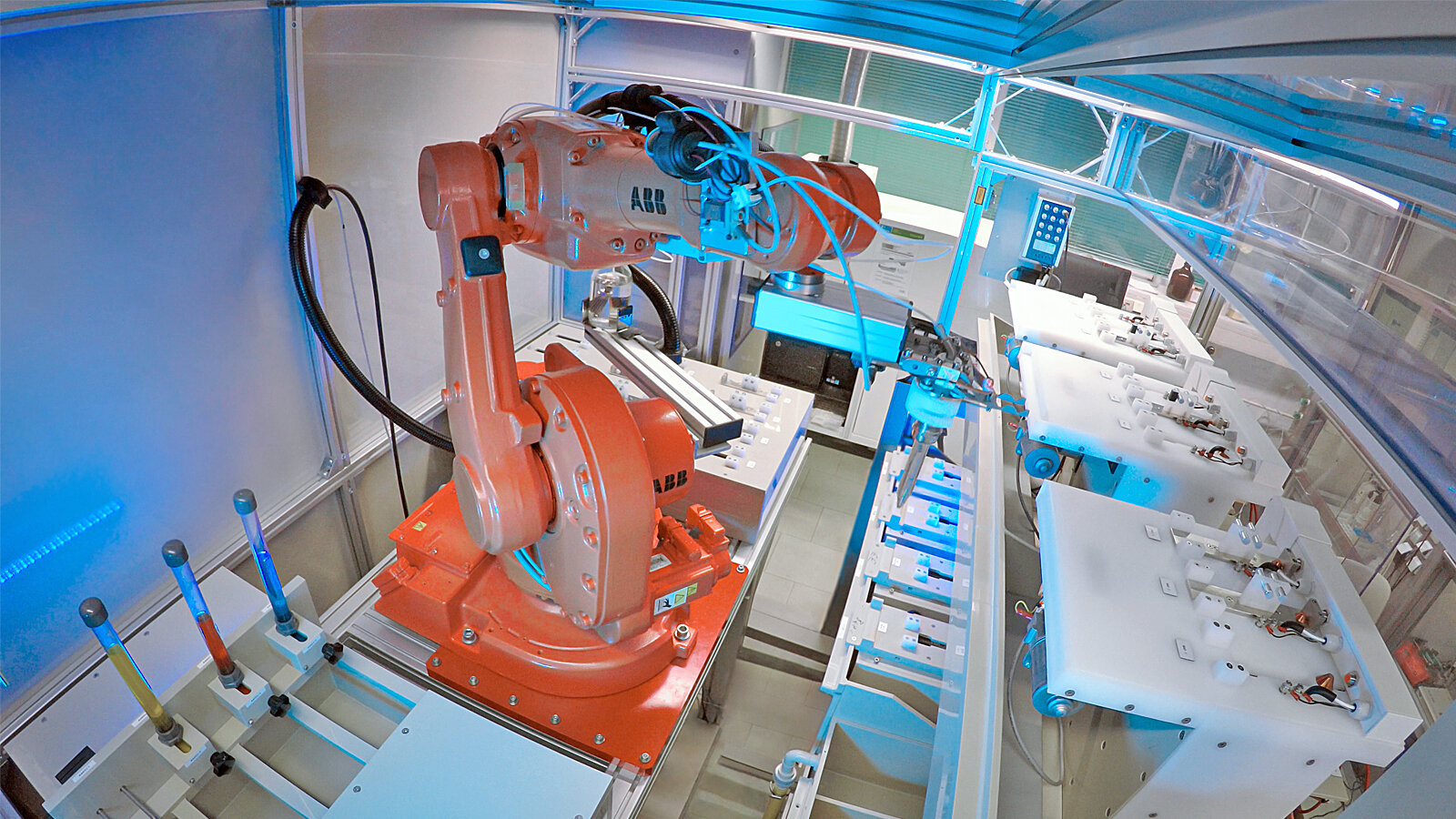Award for Chemnitz electroplating engineers
Consortium under the scientific leadership of the Chair of Materials and Surface Engineering at Chemnitz University of Technology awarded Leipziger Galvanopreis 2021 (Leipzig Electroplating Prize) for robot-assisted electroplating system
-

The robot adjusts the pH value of the process bath with a pipette before picking up the next sheet from the magazine. This step is necessary because the pH value influences the coating properties of the sheet and thus also the corrosion protection. Photo: Julius Nickisch
The Leipziger Galvanopreis (Leipzig Electroplating Prize) goes to a project on "Process and electrolyte development using a fully automated, robot-assisted electroplating system" developed as part of the German Federal Ministry of Education and Research (BMBF)’s "Innovative Electrochemistry with New Materials - InnoEMat" initiative.
The award winner is a consortium consisting of the Chair of Materials and Surface Engineering (Head: Prof. Dr. Thomas Lampke) at Chemnitz University of Technology, KleRo GmbH Roboterautomation and OTE Oberflächen- & Elektrotechnik Scheigenpflug GmbH. There was also close cooperation with B+T Oberflächentechnik GmbH, Coventya GmbH, Gazima GmbH, plating electronic GmbH and Prof. Wolfgang Paatsch (coordinator, formerly of BAM Berlin) within the framework of the joint project "REACH-compliant corrosion protection by pulse plating (ReKoPP)".
In addition to a bronze statue, a certificate, and a review in the journal Galvanotechnik, the consortium will receive the opportunity to present the topic at the Leipziger Fachseminar.
Automated development of galvanic processes
During the electroplating process, metal ions dissolved in an electroplating bath are deposited on a component under electrical polarization. In this way, metallic layers are formed which are characterized by, among other things, an attractive appearance, high corrosion resistance, and/or high wear resistance. Increasing demands on the economic efficiency and ecological safety of electroplating processes, as well as on the physiological safety and performance of the coatings, require continuous development. Due to the many factors that go into this process, however, this is associated with a high expenditure of time and personnel.
The core of the award-winning project is the resource-saving process and bath development in a fully automated electroplating process. To avoid a time-consuming trial-and-error approach, the parameters for electroplating are first narrowed down with the aid of physical calculations. Using mathematical methods, an experimental design is drawn up in order to map the influence of the most important process parameters with as few plating experiments as possible. The implementation of this experimental design is now fully automated by the robot-assisted electroplating system.
A single coating process first involves the selection and cleaning of the workpiece that will be coated, for example a steel sheet. Then the electroplating is carried out in one of eleven temperature-controlled baths where the sheet undulates to achieve a uniform coating result. After coating, the sheet is thoroughly rinsed in cascaded water baths, dried, photographed, and stored. Optimized process control in multitasking mode enables several parallel coatings, meaning the robot is seldom idle.
The areas of application for the robot-assisted electroplating system range from basic research at research institutes to application-oriented process optimization. The plant's flexibility meets the requirements of this broad application profile. Bath sizes range from 0.5 liters for chemical-saving basic research to about ten liters for plating larger quantities.
The aging of an electroplating bath is monitored by sensors during operation. Subsequent dosing or specific changes to the bath composition are carried out automatically with the aid of a pipetting device. For the power supply of the baths, 18 current sources are available, which can be connected individually or synchronized in pairs as required and can generate both direct current and high-frequency current pulses.
"In addition to the time and resource efficiency achieved, the reliability and comparability of results is increased by the objectified test execution," explains Professor Dr. Thomas Lampke, and emphasizes: "This is an important prerequisite for 'machine learning', which will favor and accelerate future innovations in the medium-sized electroplating industry." Consequently, the award-winning approach is an essential contribution on the way to Industry 4.0 in the electroplating sector.
Background: Leipziger Galvanopreis
With the Leipziger Galvanopreis, the Deutsche Gesellschaft für Galvano- und Oberflächentechnik e.V. (German Society for Electroplating and Surface Technology, DGO) honors companies and research institutes that have developed and successfully implemented innovations such as:
- plant or process engineering achievements,
- material-, energy-efficient or ecological solutions or
- strategic corporate/management concepts
For additional information, please contact Roy Morgenstern, research associate at the Chair of Materials and Surface Engineering at Chemnitz University of Technology, telephone: +49 371 531-32818, e-mail: roy.morgenstern@mb.tu-chemnitz.de.
(Author: Matthias Fejes/Translation: Chelsea Burris)
Matthias Fejes
17.02.2021




